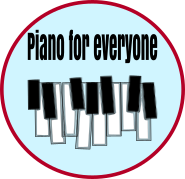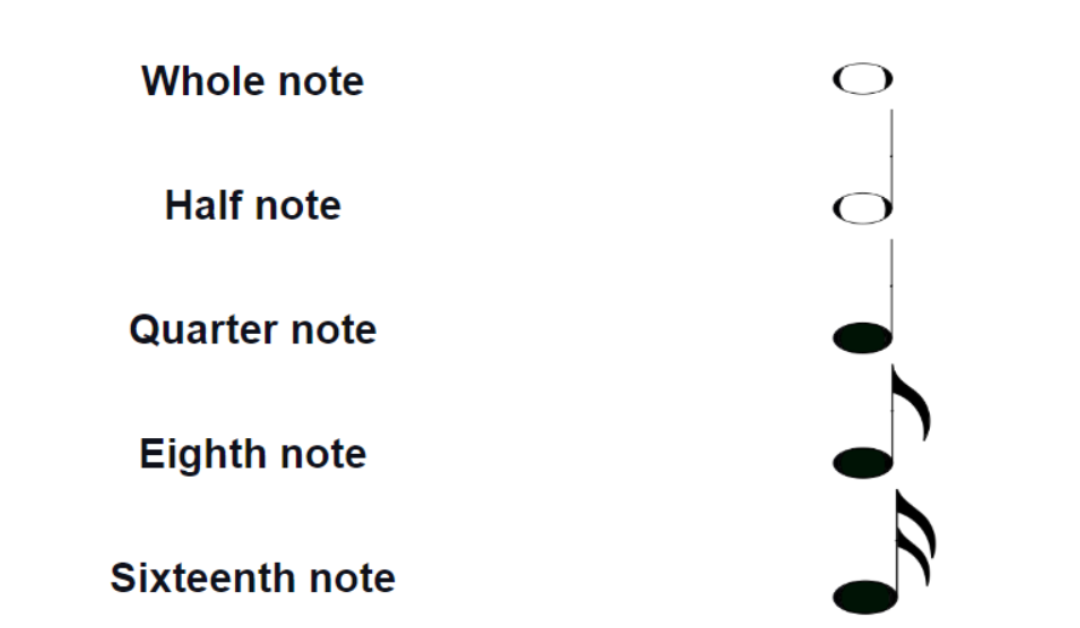Note values /rhythm/lesson 1
We can roughly, though not completely accurate, say that rhythm consists of notes that have different durations. Rhythm can affect melodies, and it can completely change their character.
Every note in music has its duration . Note duration or time value tells us how long a certain pitch will last.
All these time values look differently, and they have different lengths. On the picture above you can see the most frequently used time values.
A whole note is the longest, and it has only a note-head.
A half note has a note-head with a stem.
A quarter note has a black note-head with a stem.
Eighth note has a black note-head, steam, and one flag.
A sixteenth note has a black note-head, stem, and two flags.
Now we are going to compare the length of time values that we mentioned before

A whole note is the longest .If we divide a whole note in two, we will get two half notes.
Two half notes last as a whole note, but when we divide a half note, we will get two quartet notes.
Two quarter notes last as long as one half note and four quarter notes have the same length as one whole note.
When we divide a quarter note in two we will have two eighth notes.
When we write two or more of them next to one another we can connect them with beams. The number of beams is equal to the number of flags that would be present on a non beamed note. Eighth notes would be connected with one beam. Two eighth notes have the same length as one quarter note, four eighth notes last as long as one half note, and eight eighth notes last as long as a whole note.
If we divide the eighth note in two, we will get two sixteenth notes.
When we write two or more of them next to one another we can connect them with two beams. Two sixteenth-notes last as an eighth note, four sixteenth-notes last as a quarter note, eight sixteenth-notes last as a half note, and sixteen of them last as a whole note.
Rests
Moments of silence in music have to be written correctly, and that’s why we have different signs for that called rests. Rests indicate how long the silence will last. Just as we have signs for different time values, we also have signs for different types of rests.
We have:

A whole rest and it lasts as long as a whole note;
A half rest and it lasts as long as a half note and;
A quarter rest it lasts as long as a quarter note;
An eighth rest it lasts as long as an eighth note;
A sixteenth rest it lasts as long as a sixteenth note;
The whole rest looks very similar to half rest, but they are different from each other by their position in the staff. The whole rest is placed below the fourth line, while the half rest is placed above the third line. The other rests are placed like this.
Now you are going to see how these rests look like when they are written on the staff.

A bar which is completely silent is marked with a whole rest 4 4 bar and also 2 4 and 3 4 bars.
Time signature /rhythm/lesson 2
Since we know which time values last longer or shorter than others, we should ask ourselves a question: “What is the actual length of every time value that we mentioned before?”
We will find the answer to this question at the beginning of every composition, it’s called time signature, and it will give us some valuable information…
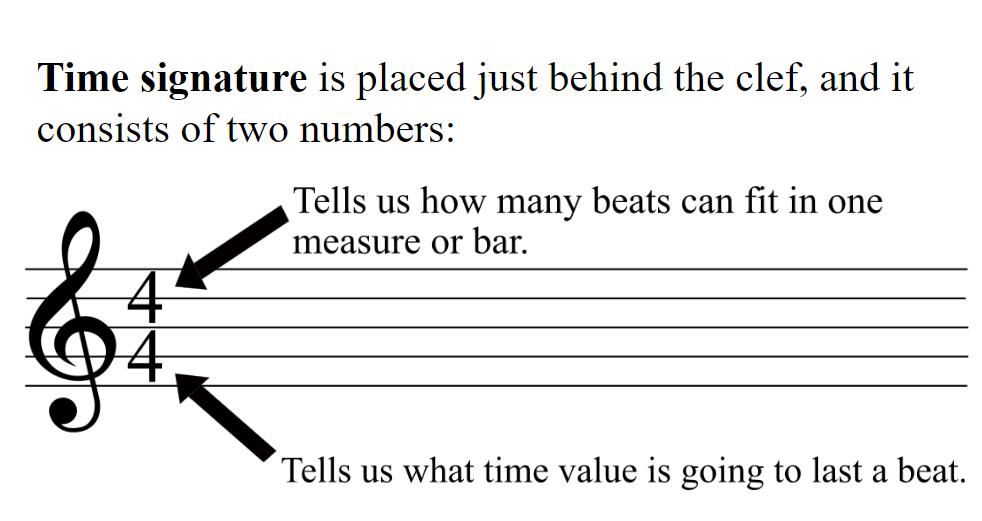
The time signature is placed just behind the cliff, and it consists of two numbers, one standing on top of another. You will see time signatures like 3 4, 4 4, 3 8, 2 2 etc.
The bottom figure tells us what time value (a beat) is going to last one beat. This means that if we have rhythm written in a time signature like three quarters, two quarters, or four quarters, a quarter note is going to last one beat. If a quarter note lasts one beat, a half note is going to last two beats, a whole note is going to last four beats. The eighth note is going to last half of a beat, and the sixteenth note is going to last quarter of a beat.

There are also other time signatures, like two eighths or three-eighths. If that’s the case, the eighth note is going to last one beat. And according to that, we will be able to determine how long will other time values last. a half note is going to last 4 beats, a whole note is going to last 8 beats. The quarter note is going to last one beat, and the sixteenth note is going to last half of a beat.
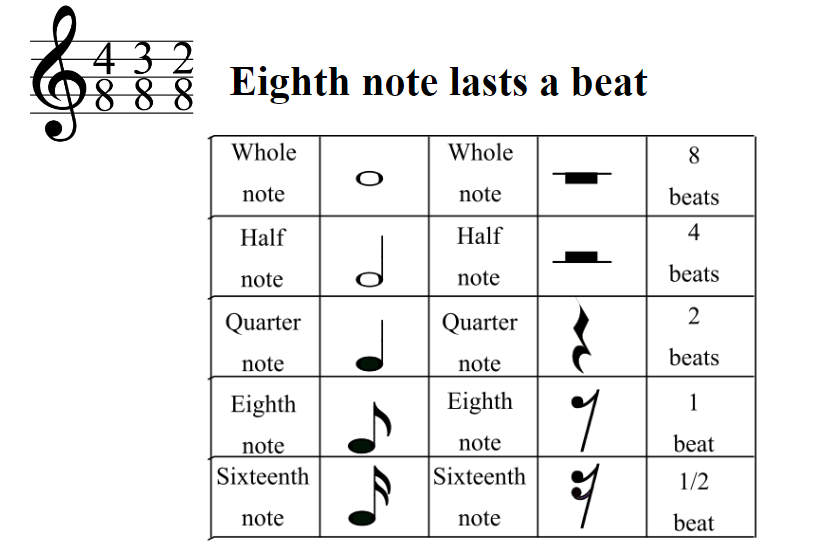
If we would have rhythm written in time signatures like two half notes, or three half notes, a half note is going to last one beat, and that will help us to determine how long will other time values last. So, if thaat’s the case
A whole note would last two beats, quarter note would last a half of a beat, eighth note would last a quarter of a beat and so on…
Now let’s get back to the time signature to see, why the top figure is important? The top figure tells us how many beats can fit in one measure or bar.
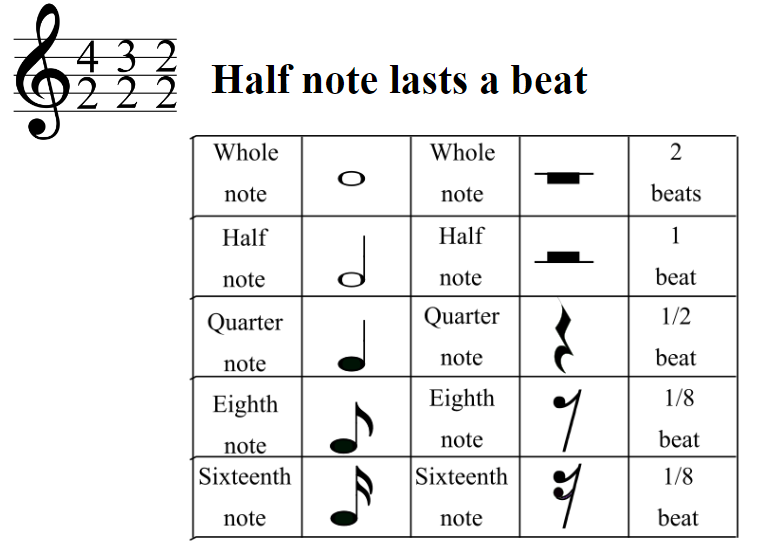
Bars or measures
are small units of music. Every bar can fit a certain amount of note durations, no more nor less. For instance, if we have 3/4 time signature, this indicates that every bar in this composition can fit the amount of notes that is equal to a duration of 3 quarter notes.
We could fit one half note and one quarter note. Or we could write two eighth notes and two quarter notes. And that’s the importance of the top figure in a time signature because it tells us how many beats can fit into a bar or measure.
Bars are divided from one another with upright lines called bar lines.
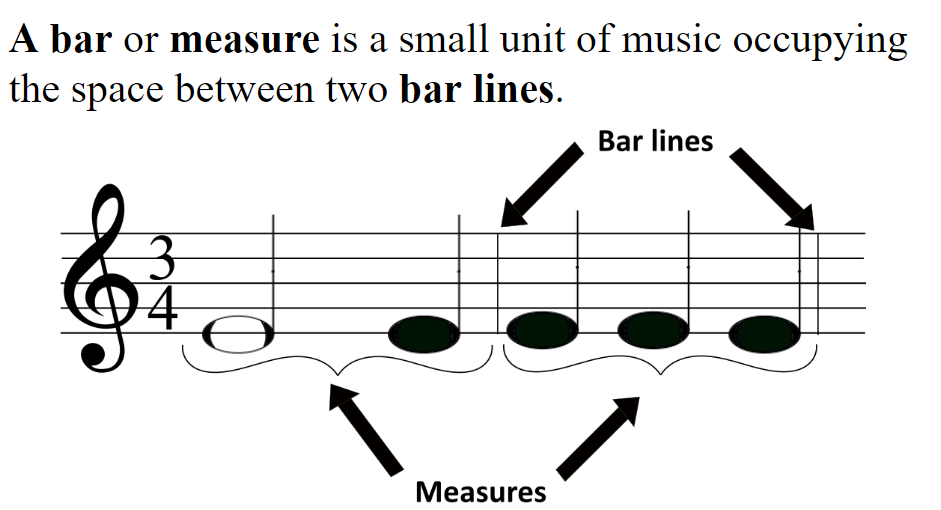
Ties and dots /rhythm/lesson 3
are used to change notes duration.
A tie is a curved line connecting the heads of two or more notes of the same pitch. Tied notes should be played as one note, and their length is equal to the sum of their individual values. We can tie as many notes as we want but they must:
- stand next to each other and
- have to have the same pitch.

A dot after a note increases notes duration by half of its value. If we have a whole note, for instance. A whole note would last four beats, but if we place a dot then its duration would be two beats longer because two is half of four. A half note would last two beats, but if we place a dot then its duration would be one beat longer because one is half of two.
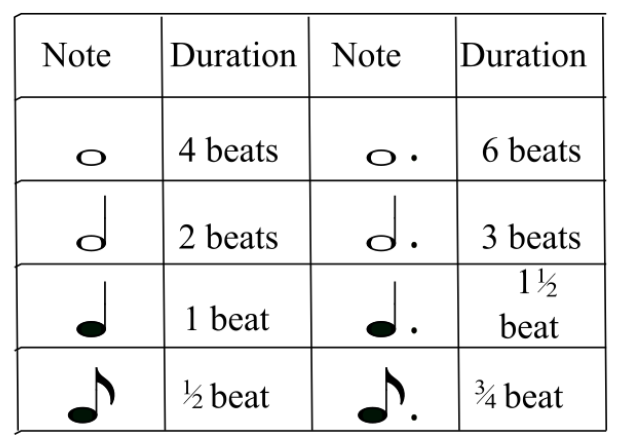
If you have any questions about musical rhythm, feel free to send me a message, and I’ll answer you ASAP.
If you liked this post, please follow us on social media.
